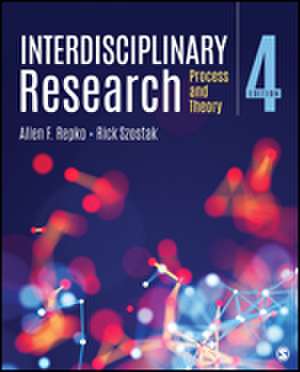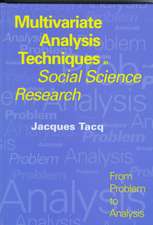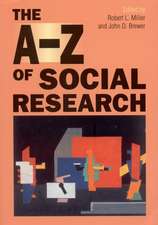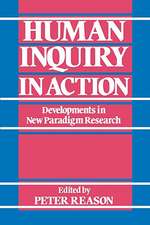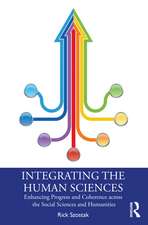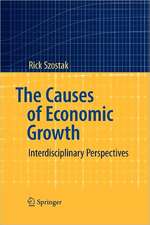Interdisciplinary Research: Process and Theory
Autor Allen F. Repko, Rick Szostaken Limba Engleză Paperback – 22 feb 2021
Preț: 696.58 lei
Preț vechi: 941.33 lei
-26% Nou
Puncte Express: 1045
Preț estimativ în valută:
133.29€ • 139.54$ • 110.29£
133.29€ • 139.54$ • 110.29£
Carte disponibilă
Livrare economică 17-31 martie
Livrare express 01-07 martie pentru 38.18 lei
Preluare comenzi: 021 569.72.76
Specificații
ISBN-13: 9781544398600
ISBN-10: 1544398603
Pagini: 472
Dimensiuni: 187 x 232 x 25 mm
Greutate: 0.75 kg
Ediția:Fourth Edition
Editura: SAGE Publications
Colecția Sage Publications, Inc
Locul publicării:Thousand Oaks, United States
ISBN-10: 1544398603
Pagini: 472
Dimensiuni: 187 x 232 x 25 mm
Greutate: 0.75 kg
Ediția:Fourth Edition
Editura: SAGE Publications
Colecția Sage Publications, Inc
Locul publicării:Thousand Oaks, United States
Recenzii
“In this Fourth Edition, Repko and Szostak have gone further to de-mystify the interdisciplinary research process. By providing students with guiding study questions within each chapter, adding extended advice on how to choose a complex research question, and illustrating that many of the strategies outlined in this text can be applied beyond the academy, they are more responsive to the needs of both professors and students.”
“Repko and Szostak’s text remains a vital guide to interdisciplinary inquiry, with clear accounts of an ideal progression from initial idea through completed project. While oriented to all levels from undergraduates to professional scholars, the book ably serves as a text for doctoral students; it has helped them achieve profound contributions. The current edition expands on instruction regarding literature searches and research questions, while encouraging students to rely on their own creativity as novel approaches are conceived and interpretations of findings sought.”
"The Fourth Edition of Interdisciplinary Research offers improved clarity and usability, particularly for undergraduate researchers. Guiding questions at the beginning of each chapter encourage readers to remain focused, and newly incorporated examples of relevant, recent research demonstrate that interdisciplinary perspectives have the power to help us understand and shape the world around us—including people, policies, and even public spaces—for the better.”
“The revised edition of Interdisciplinary Research is timely and well received! Literature on interdisciplinary research has increased and developed to include a synthesis theory and practice from around the world. This book is recommended for undergraduate and graduate students and those involved in interdisciplinary research. Instructors using this as a primary or supplemental text will find the pedagogical revisions helpful in challenging students to engage with the interdisciplinary research process. I highly recommend it.”
“Repko and Szostak’s text remains a vital guide to interdisciplinary inquiry, with clear accounts of an ideal progression from initial idea through completed project. While oriented to all levels from undergraduates to professional scholars, the book ably serves as a text for doctoral students; it has helped them achieve profound contributions. The current edition expands on instruction regarding literature searches and research questions, while encouraging students to rely on their own creativity as novel approaches are conceived and interpretations of findings sought.”
"The Fourth Edition of Interdisciplinary Research offers improved clarity and usability, particularly for undergraduate researchers. Guiding questions at the beginning of each chapter encourage readers to remain focused, and newly incorporated examples of relevant, recent research demonstrate that interdisciplinary perspectives have the power to help us understand and shape the world around us—including people, policies, and even public spaces—for the better.”
“The revised edition of Interdisciplinary Research is timely and well received! Literature on interdisciplinary research has increased and developed to include a synthesis theory and practice from around the world. This book is recommended for undergraduate and graduate students and those involved in interdisciplinary research. Instructors using this as a primary or supplemental text will find the pedagogical revisions helpful in challenging students to engage with the interdisciplinary research process. I highly recommend it.”
Cuprins
Preface
Acknowledgments
About the Authors
PART I • ABOUT INTERDISCIPLINARY STUDIES AND DISCIPLINES
Chapter 1 • Introducing Interdisciplinary Studies
Learning Outcomes
Guiding Questions
Chapter Objectives
Defining Interdisciplinary Studies
The Intellectual Essence of Interdisciplinarity
Distinguishing Interdisciplinarity From Multidisciplinarity, Transdisciplinarity, and Integrative Studies
Chapter Summary
Notes
Exercises
Chapter 2 • Introducing the Disciplines and Their Perspectives
Learning Outcomes
Guiding Questions
Chapter Objectives
Defining Disciplinary Perspective
How Knowledge Is Typically Reflected in the Organization of the Academy
Categories of Disciplines
Disciplinary Perspectives
Unpacking the Defining Elements of a Discipline’s Perspective
Chapter Summary
Notes
Exercises
PART II • DRAWING ON DISCIPLINARY INSIGHTS
Chapter 3 • Beginning the Research Process
Learning Outcomes
Guiding Questions
Chapter Objectives
The Integrated Model of the Interdisciplinary Research Process
Key Characteristics of Interdisciplinary Research
STEP 1: Define the Problem or State the Research Question
Creativity and STEP 1
STEP 2: Justify Using an Interdisciplinary Approach
Chapter Summary
Notes
Exercises
Chapter 4 • Identifying Relevant Disciplines
Learning Outcomes
Guiding Questions
Chapter Objectives
Select Potentially Relevant Disciplines
Map the Problem to Reveal Its Disciplinary Parts
Reduce the Number of Potentially Relevant Disciplines to Those That Are Most Relevant
Chapter Summary
Notes
Exercises
Chapter 5 • Conducting the Literature Search
Learning Outcomes
Guiding Questions
Chapter Objectives
Meaning of Literature Search
Reasons for Conducting the Literature Search
Special Challenges Confronting Interdisciplinarians
The Initial Literature Search
The Full-Scale Literature Search
Chapter Summary
Notes
Exercises
Chapter 6 • Developing Adequacy in Relevant Disciplines
Learning Outcomes
Guiding Questions
Chapter Objectives
The Meaning of Adequacy
Develop Adequacy in Theories
Develop Adequacy in Disciplinary Methods
Use and Evaluate Disciplinary Methods in Basic Research
Provide In-Text Evidence of Disciplinary Adequacy
Chapter Summary
Notes
Exercises
Chapter 7 • Analyzing the Problem and Evaluating Insights
Learning Outcomes
Guiding Questions
Chapter Objectives
Analyze the Problem From Each Discipline’s Perspective
Evaluate the Insights Produced by Each Discipline
Checklist for Evaluating Previous Research
Chapter Summary
Note
Exercises
PART III • INTEGRATING INSIGHTS
Chapter 8 • Understanding Integration
Learning Outcomes
Guiding Questions
Chapter Objectives
What Interdisciplinary Integration Is
The Controversy Concerning Integration
Integration in the Broad Model
Questions Raised by This Discussion of Integration
Chapter Summary
Notes
Exercises
Chapter 9 • Identifying Conflicts Among Insights and Their Sources
Learning Outcomes
Guiding Questions
Chapter Objectives
Identify Conflicting Insights
Locate Sources of Conflict Among Insights
Communicate Your Research to the Appropriate Audience
Chapter Summary
Exercises
Chapter 10 • Creating Common Ground Among Insights: Concepts and/or Assumptions
Learning Outcomes
Guiding Questions
Chapter Objectives
About Interdisciplinary Common Ground
Create Common Ground Among Conflicting Concepts and/or Assumptions
Chapter Summary
Notes
Exercises
Chapter 11 • Creating Common Ground Among Insights: Theories
Learning Outcomes
Guiding Questions
Chapter Objectives
Defining Disciplinary Theory
Models, Variables, Concepts, and Causal Relationships
Create Common Ground Among Theories
Chapter Summary
Notes
Exercises
Chapter 12 • Constructing a More Comprehensive Understanding or Theory
Learning Outcomes
Guiding Questions
Chapter Objectives
Definition of “More Comprehensive Understanding”
Be Creative
Construct the More Comprehensive Understanding From Modified Concepts and/or Assumptions
Construct a More Comprehensive Theory From a Modified Theory
Chapter Summary
Notes
Exercises
Chapter 13 • Reflecting on, Testing, and Communicating the Understanding or Theory
Learning Outcomes
Guiding Questions
Chapter Objectives
Reflect on the More Comprehensive Understanding or Theory
Test the Quality of Interdisciplinary Work
Test the More Comprehensive Understanding or Theory
Communicate the Results of Integration
Chapter Summary
Notes
Exercises
Conclusion
Appendix
Glossary of Key Terms
References
Index
Acknowledgments
About the Authors
PART I • ABOUT INTERDISCIPLINARY STUDIES AND DISCIPLINES
Chapter 1 • Introducing Interdisciplinary Studies
Learning Outcomes
Guiding Questions
Chapter Objectives
Defining Interdisciplinary Studies
The Intellectual Essence of Interdisciplinarity
Distinguishing Interdisciplinarity From Multidisciplinarity, Transdisciplinarity, and Integrative Studies
Chapter Summary
Notes
Exercises
Chapter 2 • Introducing the Disciplines and Their Perspectives
Learning Outcomes
Guiding Questions
Chapter Objectives
Defining Disciplinary Perspective
How Knowledge Is Typically Reflected in the Organization of the Academy
Categories of Disciplines
Disciplinary Perspectives
Unpacking the Defining Elements of a Discipline’s Perspective
Chapter Summary
Notes
Exercises
PART II • DRAWING ON DISCIPLINARY INSIGHTS
Chapter 3 • Beginning the Research Process
Learning Outcomes
Guiding Questions
Chapter Objectives
The Integrated Model of the Interdisciplinary Research Process
Key Characteristics of Interdisciplinary Research
STEP 1: Define the Problem or State the Research Question
Creativity and STEP 1
STEP 2: Justify Using an Interdisciplinary Approach
Chapter Summary
Notes
Exercises
Chapter 4 • Identifying Relevant Disciplines
Learning Outcomes
Guiding Questions
Chapter Objectives
Select Potentially Relevant Disciplines
Map the Problem to Reveal Its Disciplinary Parts
Reduce the Number of Potentially Relevant Disciplines to Those That Are Most Relevant
Chapter Summary
Notes
Exercises
Chapter 5 • Conducting the Literature Search
Learning Outcomes
Guiding Questions
Chapter Objectives
Meaning of Literature Search
Reasons for Conducting the Literature Search
Special Challenges Confronting Interdisciplinarians
The Initial Literature Search
The Full-Scale Literature Search
Chapter Summary
Notes
Exercises
Chapter 6 • Developing Adequacy in Relevant Disciplines
Learning Outcomes
Guiding Questions
Chapter Objectives
The Meaning of Adequacy
Develop Adequacy in Theories
Develop Adequacy in Disciplinary Methods
Use and Evaluate Disciplinary Methods in Basic Research
Provide In-Text Evidence of Disciplinary Adequacy
Chapter Summary
Notes
Exercises
Chapter 7 • Analyzing the Problem and Evaluating Insights
Learning Outcomes
Guiding Questions
Chapter Objectives
Analyze the Problem From Each Discipline’s Perspective
Evaluate the Insights Produced by Each Discipline
Checklist for Evaluating Previous Research
Chapter Summary
Note
Exercises
PART III • INTEGRATING INSIGHTS
Chapter 8 • Understanding Integration
Learning Outcomes
Guiding Questions
Chapter Objectives
What Interdisciplinary Integration Is
The Controversy Concerning Integration
Integration in the Broad Model
Questions Raised by This Discussion of Integration
Chapter Summary
Notes
Exercises
Chapter 9 • Identifying Conflicts Among Insights and Their Sources
Learning Outcomes
Guiding Questions
Chapter Objectives
Identify Conflicting Insights
Locate Sources of Conflict Among Insights
Communicate Your Research to the Appropriate Audience
Chapter Summary
Exercises
Chapter 10 • Creating Common Ground Among Insights: Concepts and/or Assumptions
Learning Outcomes
Guiding Questions
Chapter Objectives
About Interdisciplinary Common Ground
Create Common Ground Among Conflicting Concepts and/or Assumptions
Chapter Summary
Notes
Exercises
Chapter 11 • Creating Common Ground Among Insights: Theories
Learning Outcomes
Guiding Questions
Chapter Objectives
Defining Disciplinary Theory
Models, Variables, Concepts, and Causal Relationships
Create Common Ground Among Theories
Chapter Summary
Notes
Exercises
Chapter 12 • Constructing a More Comprehensive Understanding or Theory
Learning Outcomes
Guiding Questions
Chapter Objectives
Definition of “More Comprehensive Understanding”
Be Creative
Construct the More Comprehensive Understanding From Modified Concepts and/or Assumptions
Construct a More Comprehensive Theory From a Modified Theory
Chapter Summary
Notes
Exercises
Chapter 13 • Reflecting on, Testing, and Communicating the Understanding or Theory
Learning Outcomes
Guiding Questions
Chapter Objectives
Reflect on the More Comprehensive Understanding or Theory
Test the Quality of Interdisciplinary Work
Test the More Comprehensive Understanding or Theory
Communicate the Results of Integration
Chapter Summary
Notes
Exercises
Conclusion
Appendix
Glossary of Key Terms
References
Index
Notă biografică
Allen F. Repko, PhD, is the former director of the interdisciplinary studies program in the School of Urban and Public Affairs at the University of Texas at Arlington, where he developed and taught the program¿s core curriculum for many years. The program is one of the largest in the United States. Repko has written extensively on all aspects of interdisciplinary studies, has twice served as coeditor of the interdisciplinary journal Issues in Integrative Studies, and has served on the board of the Association for Interdisciplinary Studies (AIS).
Descriere
Interdisciplinary Research: Process and Theory offers a comprehensive, systematic presentation of the interdisciplinary decision-making process by drawing on student and professional work from the natural sciences, social sciences, humanities, and applied fields.
